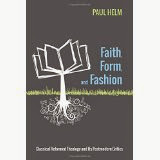This is the fourth post in a series on
Particular Baptist theology and its confessional roots. In it I shall sketch
what are some good grounds for thinking that such theology takes a distinctive
position on the covenant, or covenants, as we shall see. There is a
considerable recent literature on this theme, from which I have learned a good
deal. Because of this, my account will be sketchy. What I wish eventually to
draw from this discussion of the covenants are some ecclesiastical
consequences, which are touched on occasionally in the modern discussion. But
more could be made of them, I believe. Such a view of the covenants seems to me
to be critical for an overall account of the coherence of a Particular Baptist
position.
First, a brief discussion of the differences
between the Westminster Confession (1647) on the covenant, and the Baptist Confession of 1689. Then a discussion
of the distinctive position adopted by some Baptists and some others. The hermeneutical implications for the Baptist
view of the church will come in a
following post.
The Confessional position
This is part of the wording of the covenant
of grace in the Baptist Confession of 1689
It
pleased the Lord to make a covenant of grace, wherein he freely offereth to
sinners life and salvation by Jesus Christ….This covenant is revealed in the
gospel: first of all to Adam…and afterwards by further steps, until the full
discovery thereof was completed in the New Testament.
This wording presents quite a different form
of the revealing of the gospel from that of the Westminster Confession. The
emphasis is on the gradual unfolding rather than a sharp revelation of the
covenant that the Westminster Confession provides. (One covenant of grace, two
administrations.) In the Baptist account there is a gradualist understanding of
this ‘discovery’ (i.e. disclosing) of the covenant. The differences must not be
exaggerated, but they are quite distinct, and the Baptist wording gives the covenant
of grace a flavor of its own. (The Savoy
Declaration (1658) is different in wording but very similar in meaning to the
1689 Baptist Confession, speaking of the covenant ‘being differently and
variously administered in respect of ordinancies and institutions in the time
of the law, and since the coming of
Christ in the flesh’. Yet it is ‘one and the same’…’covenant of grace (7.5))
The gradualist approach that we notice is to
be understood as permitting a disentangling of the gospel from the law, in the
case of Moses, and those matters which according to the Epistle to the Hebrews
by now have ‘faded away’. (In the case of Abraham, the wording makes possible a
similar disentangling of the progeny of Abraham as regards the scope of the covenant
of grace. We’ll look at Abraham next time). With these disentanglings there comes
an appreciation of the fact that under the Mosaic covenant different things
were going on under the same administration. Some of these things were babyish
representations of that covenant, destined to pass away. Others were social
institutions that were intended to guard the integrity of the covenant people from
the surrounding culture. (Gal.4. 2-3) Throughout there were also typical
elements foreshadowing the coming of the covenant of grace in its fullness. I
think that this may best be understood if we first consider the Mosaic covenant,
and then the Abrahamic covenant. This appreciation of the gradual
implementation of the covenant also provides for Jeremiah 31. 31, widely quoted
and alluded to the New Testament, being
given its full weight. as we shall note later.
Moses
Paul’s teaching about the purpose of the law
in Galatians is significant and critical. It is an important fact for him that
the law came after the covenant was established,
when it was first promised to Adam and given explicit covenantal form to Abraham.
In that covenant with Abraham there is both an eternal and a temporal element.
The law when it came to Moses was in fact a fulfillment of the covenant to
Abraham in its temporal sense. The Mosaic law, as long as it endured, was as a
fence, a guardian, ‘until Christ came, in order that we might be justified by
faith’. ‘But now that faith has come, we are no longer under a guardian, for in
Christ Jesus you are all sons if God through faith. For as many of you as were
baptized into Christ have put in Christ’.
Although we often concentrate on the failure of Israel, Paul does not
focus on failure. (Gal. 3.24-7) The law
despite the faithlessness of the people nevertheless served to keep a nation together
until, despite exile and colonisation, until the coming of Christ. This temporary
arrangement served the purposes of the outworking and flourishing of the covenant
of grace, but was not itself an expression of that covenant, except in certain
typological respects à la Letter to the Hebrews. It embraced both the moral,
the judicial and the ceremonial law, looking forward to what which was to come
in ‘the fullness of time’, when God sent his Son. The blessings of the covenant
to those who are largely but not universally embedded within the line of Isaac.
But why did that covenant have this role as
a guardian? It was the preservative condition for a time, preserving those Jews
benefitting from its terms from cultural exposure to the surrounding nations and
cults, for example. Its law and its penalties helped to erect and keep in place
a preserving barrier for the coming of the messianic age. It did not itself
confer the benefits of the covenant of grace.
But there were beneficiaries of the covenant
of grace during that period as we can see from the heroes of faith of Hebrews
11, and from the deep faith of a remnant of the nation who welcomed the Messiah
who came at the appointed time, in the fulness of time. In the detail of the OT
there is evidence of a remnant within the nation who had received ‘circumcision
of the heart’ (Deut.10.16; Rom. 2.28-9). Such poor and needy Jews, who feared
the Lord, whose piety is expressed in the Psalms, who in the time of Elijah did
not ‘bow the knee to Baal’, and so on.
Israel and ‘not Israel’
Then at the time of the coming of the
Messiah there were individuals such as Anna and Simeon and the extended family
of Jesus – his mother Mary (and no doubt Joseph), Elizabeth and Zechariah,
whose lives we get a glimpse of, particularly in Luke’s gospel – in the words
of the Magnificat and of Zechariah’s
prophecy in Luke 1, in which the events of the new covenant are described using
the conceptuality of the Old. Mary speaks of God remembering his mercy ‘as he
spoke to our fathers, to Abraham and to his offspring for ever’ (Lk. 1.55); and
Simeon who ‘was waiting for the consolation of Israel’ (2.25) and Anna the prophetess who spoke of
God ‘to all who were waiting for the redemption of Jerusalem’. (2.38)
At the same time there is evidence of the
weaving of Gentiles into the history of Israel, and even of them being in the
human line of the Messiah, typified by Ruth the Moabitess. So it was true of
the history of Israel throughout, as it was true in Paul’s time: ‘So too at the
present time there is a remnant, chosen by grace’ (Rom.11.5). And as Peter
declared at the Council of Jerusalem, as the Gentiles were grafted in, in that
sense that ‘the tent of David was being rebuilt…..that the remnant of mankind
may seek the Lord, and all the Gentiles
who are called by my name.’ (Acts 15.16) There are two principles at
work here: ‘Not all who are descended from Israel belong to Israel’ (Rom.9.6) and ‘Those who were not my
people I will call “my people”’. (v. 25) Who are these? Those ‘whom he has
called, not only from the Jews only but also from the Gentiles’. (Rom. 9.24)
Paul then cites Hosea’s prophecy, part of which has just been quoted, and words
from Isaiah.
In the next post we shall look a little at
the Abrahamic covenant, and then try to make sense of all this in terms of the
outworking of the covenant of grace in pre-Incarnation and post-Incarnation history.








